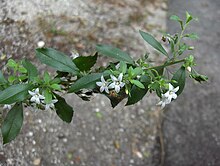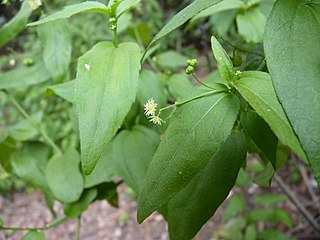| Ditaxis | |
|---|---|
 | |
| Ditaxis argothamnoides | |
| Scientific classification | |
| Kingdom: | Plantae |
| Clade: | Tracheophytes |
| Clade: | Angiosperms |
| Clade: | Eudicots |
| Clade: | Rosids |
| Order: | Malpighiales |
| Family: | Euphorbiaceae |
| Tribe: | Chrozophoreae |
| Subtribe: | Ditaxinae |
| Genus: | Ditaxis |
| Species: | Ditaxis |
| Binomial name | |
| Ditaxis | |
| Synonyms [1] | |
| |
Ditaxis is a plant genus of the family Euphorbiaceae first described as a genus in 1824. [2] [3] Its name comes from Greek dis ("two") and taxis ("rank"), referring to the stamens which are in two whorls. The genus is widespread across much of the Western Hemisphere from the southern United States to Uruguay. [1] [4] [5] [6] [7]
- Species [1]
- Ditaxis acaulis - S Brazil, NE Argentina, Paraguay, Uruguay
- Ditaxis adenophora - Arizona, Sonora, S California
- Ditaxis aphoroides - S Texas
- Ditaxis argothamnoides - Florida, Aruba, Curaçao, Trinidad, Colombia, Venezuela
- Ditaxis arlynniana - Coahuila
- Ditaxis brandegeei - Arizona, Baja California, Baja California Sur, Sonora
- Ditaxis breviramea - Bolivia, Paraguay, NW Argentina
- Ditaxis calycina - Leeward Islands
- Ditaxis catamarcensis - N Argentina
- Ditaxis clariana - SE California, SW Arizona, Baja California
- Ditaxis cuneifolia - Espírito Santo
- Ditaxis cyanophylla - Arizona, New Mexico
- Ditaxis depressa - Puebla
- Ditaxis desertorum - Bahia
- Ditaxis dioica - Peru
- Ditaxis erubescens - Venezuela incl islands in Caribbean
- Ditaxis fasciculata - Cuba, Puerto Rico, Lesser Antilles, NE Brazil
- Ditaxis gardneri - Ceará
- Ditaxis guatemalensis - Mexico, Central America
- Ditaxis haitiensis - Hispaniola
- Ditaxis heterantha - Mexico
- Ditaxis humilis - from Kansas + Colorado south to Durango
- Ditaxis illimaniensis - Bolivia
- Ditaxis jablonszkyana - NW Argentina
- Ditaxis katharinae - Peru
- Ditaxis lanceolata - California, Arizona, Baja California
- Ditaxis macrantha - Ecuador
- Ditaxis macrobotrys - Panama
- Ditaxis malmeana - Mato Grosso
- Ditaxis malpighiacea - Piauí, Pernambuco
- Ditaxis malpighipila - Argentina from Mendoza to Rio Negro
- Ditaxis manzanilloana - Oaxaca, Colima
- Ditaxis mercurialina - Arkansas, Kansas, Texas, New Mexico, Mexico
- Ditaxis montevidensis - S Brazil, NE Argentina, Paraguay, Uruguay
- Ditaxis pilosissima - Texas
- Ditaxis polygama - West Indies, Colombia, Venezuela
- Ditaxis pringlei - Oaxaca, Morelos, Jalisco
- Ditaxis purpurascens - Mato Grosso
- Ditaxis rhizantha - Uruguay
- Ditaxis rosularis - NW Argentina, Paraguay
- Ditaxis rubricaulis - Venezuela incl islands in Caribbean
- Ditaxis salina - Paraguay, Formosa
- Ditaxis sellowiana - S Brazil
- Ditaxis serrata - Mexico, Guatemala, SW United States
- Ditaxis simoniana - E + SE Brazil
- Ditaxis simulans - Texas, Coahuila
- formerly included [1]
moved to other genera (Adelia Argythamnia Caperonia Chiropetalum Philyra)
- D. argentea - Argythamnia argentea
- D. brasiliensis - Philyra brasiliensis
- D. castaneifolia - Caperonia castaneifolia
- D. chiropetala - Chiropetalum berteroanum
- D. cordata - Caperonia cordata
- D. haemiolandra - Adelia ricinella
- D. linearifolia - Caperonia linearifolia
- D. polymorpha - Caperonia heteropetala
- D. polymorpha var. brevifolia - Caperonia aculeolata
- D. polymorpha var. buttnerioides - Caperonia heteropetala
- D. polymorpha var. longifolia - Caperonia heteropetala
- D. tinctoria - Argythamnia tinctoria

















